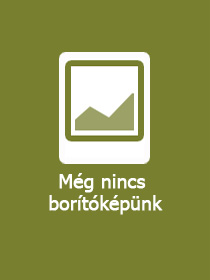
Semantics, Pragmatics, Philosophy
A Journey through Meaning
-
10% KEDVEZMÉNY?
- A kedvezmény csak az 'Értesítés a kedvenc témákról' hírlevelünk címzettjeinek rendeléseire érvényes.
- Kiadói listaár GBP 27.99
-
14 165 Ft (13 491 Ft + 5% áfa)
Az ár azért becsült, mert a rendelés pillanatában nem lehet pontosan tudni, hogy a beérkezéskor milyen lesz a forint árfolyama az adott termék eredeti devizájához képest. Ha a forint romlana, kissé többet, ha javulna, kissé kevesebbet kell majd fizetnie.
- Kedvezmény(ek) 10% (cc. 1 417 Ft off)
- Discounted price 12 749 Ft (12 142 Ft + 5% áfa)
14 165 Ft

Beszerezhetőség
Becsült beszerzési idő: A Prosperónál jelenleg nincsen raktáron, de a kiadónál igen. Beszerzés kb. 3-5 hét..
A Prosperónál jelenleg nincsen raktáron.
Why don't you give exact delivery time?
A beszerzés időigényét az eddigi tapasztalatokra alapozva adjuk meg. Azért becsült, mert a terméket külföldről hozzuk be, így a kiadó kiszolgálásának pillanatnyi gyorsaságától is függ. A megadottnál gyorsabb és lassabb szállítás is elképzelhető, de mindent megteszünk, hogy Ön a lehető leghamarabb jusson hozzá a termékhez.
A termék adatai:
- Kiadó Cambridge University Press
- Megjelenés dátuma 2023. március 16.
- ISBN 9781108731041
- Kötéstípus Puhakötés
- Terjedelem438 oldal
- Méret 245x171x20 mm
- Súly 850 g
- Nyelv angol 557
Kategóriák
Rövid leírás:
Combining semantics, pragmatics, and philosophy, this is a guide on how to think about meaning like a linguist and philosopher.
TöbbHosszú leírás:
Semantics and pragmatics - the study of meaning, and meaning in context, respectively - are two fundamental areas of linguistics, and as such are crucial to our understanding of how meaning is created. However, their theoretical ideas are often introduced without making clear connections between views, theories, and problems. This pioneering volume is both a textbook and a research guide, taking the reader on a journey through language and ultimately enabling them to think about meaning as linguists and philosophers would. Assuming no prior knowledge of linguistics, it introduces semantics, pragmatics, and the philosophy of language, showing how all three fields can address the 'big questions' that run through the study of meaning. It covers key theories and approaches, while also enabling increasingly more sophisticated questions about the interconnected aspects of meaning, with the end goal of preparing the reader to make their own, original contributions to ideas about meaning.
'... the book is incredibly lucid and clear, and it is a fantastic resource for researchers and Ph.D. students.' Fabrizio Macagno, Journal of Pragmatics
Tartalomjegyzék:
Preface and tips on how to read this book; Acknowledgements; List of abbreviations and symbols; Stage 1. Introduction: meaning - what it is and where to find it: 1.1 How (not) to study meaning; 1.2 Semantics, pragmatics, and philosophy (and why they are best done together); 1.3 Proposition: a flexible unit for studying meaning?; 1.4 Meaning and its correlates; Stage 2. word meaning and concepts: 2.1 Harnessing word meaning; 2.2 The 'concept' commotion; 2.3 Language and thought; 2.4 Lexicon and pragmatics; 2.5 The role of reference; Stage 3. Composing sentence meaning: tools and their purpose: 3.1 Truth in service of meaning: truth conditions and truth-value judgements; 3.2 The metalanguage for the logical form; 3.3 Possible worlds and models; 3.4 Semantic composition and semantic types; 3.5 Type-theoretic metalanguage and lambda abstraction; 3.6 Formal tools and cognitive reality; Stage 4. Operations on sentences: 4.1 Sentential connectives and propositional logic; 4.2 Conjunction; 4.3 Disjunction; 4.4 Conditional and biconditional; 4.5 Negation; 4.6 Linguistic diversity: snakes and ladders, cluedo, and monopoly; Stage 5. Inside the sentence: 5.1 Limitations of the metalanguage; 5.2 Quantification; 5.3 Representing time; 5.4 Modality; 5.5 Propositional attitude reports; 5.6 Interim conclusions: semantic tools for formal cognitive representations?; Stage 6. Conveying information: 6.1 From sentences to discourses: dynamic semantics for dynamic meaning; 6.2 Referring and its tools; 6.3 Organizing information in discourse; Stage 7. Utterance meaning, or what lurks under the surface: 7.1 Saying, implicating and inferring; 7.2. Truth-conditional vs. non-truth-conditional, semantic vs. pragmatic: what to include and what to leave out; 7.3 Keeping semantics and pragmatics apart; Stage 8. Meaning in service of its makers: 8.1 Who needs literal meanings?; 8.2 What makes a metaphor; 8.3. Speech and action; 8.4 At a crossroads with ethical and social debates; Stage 9. Conclusion: the future of meaning?; Index.
Több

Semantics, Pragmatics, Philosophy: A Journey through Meaning
Iratkozzon fel most és részesüljön kedvezőbb árainkból!
Feliratkozom
14 165 Ft

How to Engage Policy Makers with Your Research: The Art of Informing and Impacting Policy
Iratkozzon fel most és részesüljön kedvezőbb árainkból!
Feliratkozom
17 182 Ft

Cyber Security Impact on Digitalization and Business Intelligence: Big Cyber Security for Information Management: Opportunities and Challenges
Iratkozzon fel most és részesüljön kedvezőbb árainkból!
Feliratkozom
81 696 Ft

Digital Transformation and Innovation in Tourism Events
Iratkozzon fel most és részesüljön kedvezőbb árainkból!
Feliratkozom
73 384 Ft



